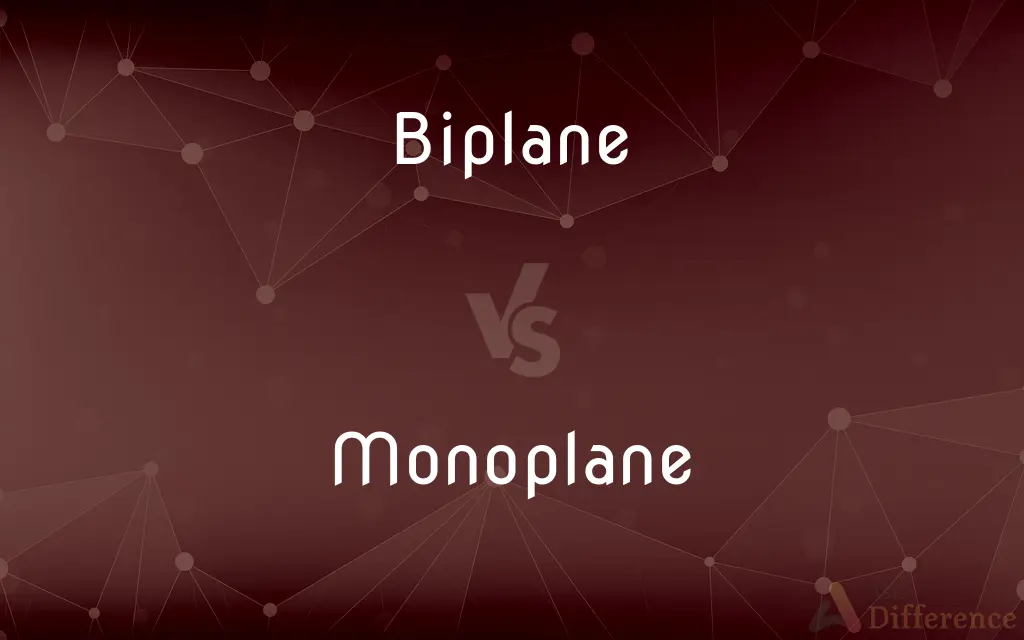Biplane vs. Monoplane — What's the Difference?
By Tayyaba Rehman & Maham Liaqat — Updated on March 14, 2024
Biplane designs feature two wings stacked vertically for structural strength, whereas monoplanes have a single wing, offering better aerodynamics and speed.

Difference Between Biplane and Monoplane
Table of Contents
ADVERTISEMENT
Key Differences
Biplanes, with their two wings, offer increased lift and structural support, beneficial for lower-speed flight and sturdiness in earlier aviation days. On the other hand, monoplanes, with their single-wing design, benefit from reduced drag and weight, leading to higher speeds and fuel efficiency.
The biplane configuration allows for shorter wingspans, which is advantageous for maneuverability and operation in confined spaces, whereas monoplanes require longer wings for the same amount of lift, affecting their agility but favoring aerodynamic efficiency.
Biplanes traditionally have a more complex structure due to the additional wing and support struts, which can increase maintenance requirements and reduce visibility for pilots. Monoplanes, in contrast, offer simpler construction and maintenance, along with improved pilot visibility due to the absence of upper wings blocking the view.
In terms of historical significance, biplanes dominated early aviation and were widely used during World War I for their stability and ease of control. Monoplanes gained prominence in the interwar period, eventually becoming the standard in both military and civilian aviation for their performance advantages.
Biplanes are often associated with vintage or stunt flying in modern times, appreciated for their nostalgic value and unique flying characteristics. Meanwhile, monoplanes are the backbone of contemporary aviation, used extensively in commercial, military, and private sectors due to their efficiency and versatility.
ADVERTISEMENT
Comparison Chart
Wing Configuration
Two wings stacked vertically
Single wing
Aerodynamics
Higher drag, lower speed
Lower drag, higher speed
Structural Complexity
More complex due to additional wings and support struts
Simpler structure
Historical Period
Dominant in early aviation and WWI
Became standard in interwar period to present
Current Use
Vintage and stunt flying
Commercial, military, and private sectors
Compare with Definitions
Biplane
Characterized by a distinct, nostalgic silhouette.
The biplane's silhouette against the sunset evoked an era long past.
Monoplane
Favored for its aerodynamic efficiency and speed.
The racer chose a monoplane for its superior speed capabilities.
Biplane
Aircraft design prevalent in the early 20th century.
The museum featured a restored biplane from World War I.
Monoplane
Offers improved fuel efficiency over older designs.
The new monoplane models boast remarkable fuel efficiency.
Biplane
Used for enhanced stability at slower speeds.
The biplane excelled in maneuverability during the air show.
Monoplane
The standard in commercial, military, and private aviation.
The airline's fleet consists entirely of advanced monoplanes.
Biplane
A plane with two main wings, one above the other.
The biplane's dual wings were visible as it soared above the countryside.
Monoplane
Represents modern aviation design.
The latest jet is a highly efficient monoplane.
Biplane
Often associated with stunt flying and vintage aviation.
Enthusiasts gathered to watch the classic biplane perform loops.
Monoplane
An aircraft with a single main wing configuration.
The sleek monoplane was ready for takeoff at dawn.
Biplane
A biplane is a fixed-wing aircraft with two main wings stacked one above the other. The first powered, controlled aeroplane to fly, the Wright Flyer, used a biplane wing arrangement, as did many aircraft in the early years of aviation.
Monoplane
A monoplane is a fixed-wing aircraft configuration with a single main wing plane, in contrast to a biplane or other multiplane, which have multiple planes. A monoplane has inherently the highest efficiency and lowest drag of any wing configuration and is the simplest to build.
Biplane
An airplane having two pairs of wings fixed at different levels, especially one above and one below the fuselage.
Monoplane
An airplane having a single pair of wings.
Biplane
Composed of, or relating to, two planes flat surfaces extending infinitely in all directions.
Biplane angiography
Monoplane
Composed of, or relating to, a single plane flat surface extending infinitely in all directions.
Biplane
(aviation) Having, or consisting of, two superposed planes, aerocurves, etc.
A biplane rudder
Monoplane
(aviation) An airplane that has a single pair of wings.
Biplane
(aviation) An airplane that has two main wings, one above the other and supported by struts.
Monoplane
(rare) To fly in a monoplane.
Biplane
To fly in a biplane.
Monoplane
An airplane with a single wing
Biplane
An aëroplane with two main supporting surfaces one above the other.
Biplane
Having, or consisting of, two superposed planes, aërocurves, or the like; of or pertaining to a biplane; as, a biplane rudder.
Biplane
Old fashioned airplane; has two wings one above the other
Common Curiosities
Can biplanes perform stunts better than monoplanes?
Biplanes are often preferred for certain stunts due to their structural strength and maneuverability, although monoplanes can also be highly agile.
What is a monoplane?
A monoplane is an aircraft with a single main wing, offering improved aerodynamics and speed.
Why were biplanes popular in early aviation?
Biplanes offered enhanced lift and structural support, making them suitable for the low-speed, low-power engines of early aviation.
How do the wing spans of biplanes and monoplanes compare?
Biplanes typically have shorter wingspans for the same lift, benefiting maneuverability, whereas monoplanes have longer wings for efficiency.
What is a biplane?
A biplane is an aircraft with two main wings stacked vertically to provide increased lift and structural strength.
Are biplanes still used today?
Yes, biplanes are still used today, primarily for recreational flying, vintage airshows, and stunt performances.
Are monoplanes more fuel-efficient than biplanes?
Yes, the aerodynamic efficiency and reduced weight of monoplanes generally lead to better fuel efficiency.
How do monoplanes compare to biplanes in terms of speed?
Monoplanes are generally faster than biplanes due to their lower drag and more efficient aerodynamic design.
Why do modern aircraft predominantly use the monoplane design?
Modern aircraft favor the monoplane design for its efficiency, speed, and lower maintenance requirements.
Is there a difference in the structural complexity between biplanes and monoplanes?
Yes, biplanes are more structurally complex due to their additional wing and support structures, making them heavier and more maintenance-intensive.
How does the pilot's visibility in a biplane compare to that in a monoplane?
Pilot visibility in a biplane can be obstructed by the upper wing and supports, whereas monoplanes offer clearer visibility.
Do biplanes have an advantage over monoplanes in any specific areas?
Biplanes excel in stability and are capable of taking off and landing in shorter distances, which can be advantageous in certain situations.
What role did biplanes and monoplanes play in military aviation?
Biplanes were key in early military aviation, particularly during World War I. Monoplanes later dominated due to their superior speed and capabilities.
How did the transition from biplanes to monoplanes affect aviation?
The transition led to advancements in speed, efficiency, and the overall capabilities of aircraft, shaping modern aviation.
What advancements made monoplanes more popular than biplanes?
Improvements in engine power, materials, and aerodynamic understanding favored the simpler, more efficient monoplane design.
Share Your Discovery

Previous Comparison
Problem vs. Conflict
Next Comparison
Pivot vs. HingeAuthor Spotlight
Written by
Tayyaba RehmanTayyaba Rehman is a distinguished writer, currently serving as a primary contributor to askdifference.com. As a researcher in semantics and etymology, Tayyaba's passion for the complexity of languages and their distinctions has found a perfect home on the platform. Tayyaba delves into the intricacies of language, distinguishing between commonly confused words and phrases, thereby providing clarity for readers worldwide.
Co-written by
Maham Liaqat















































